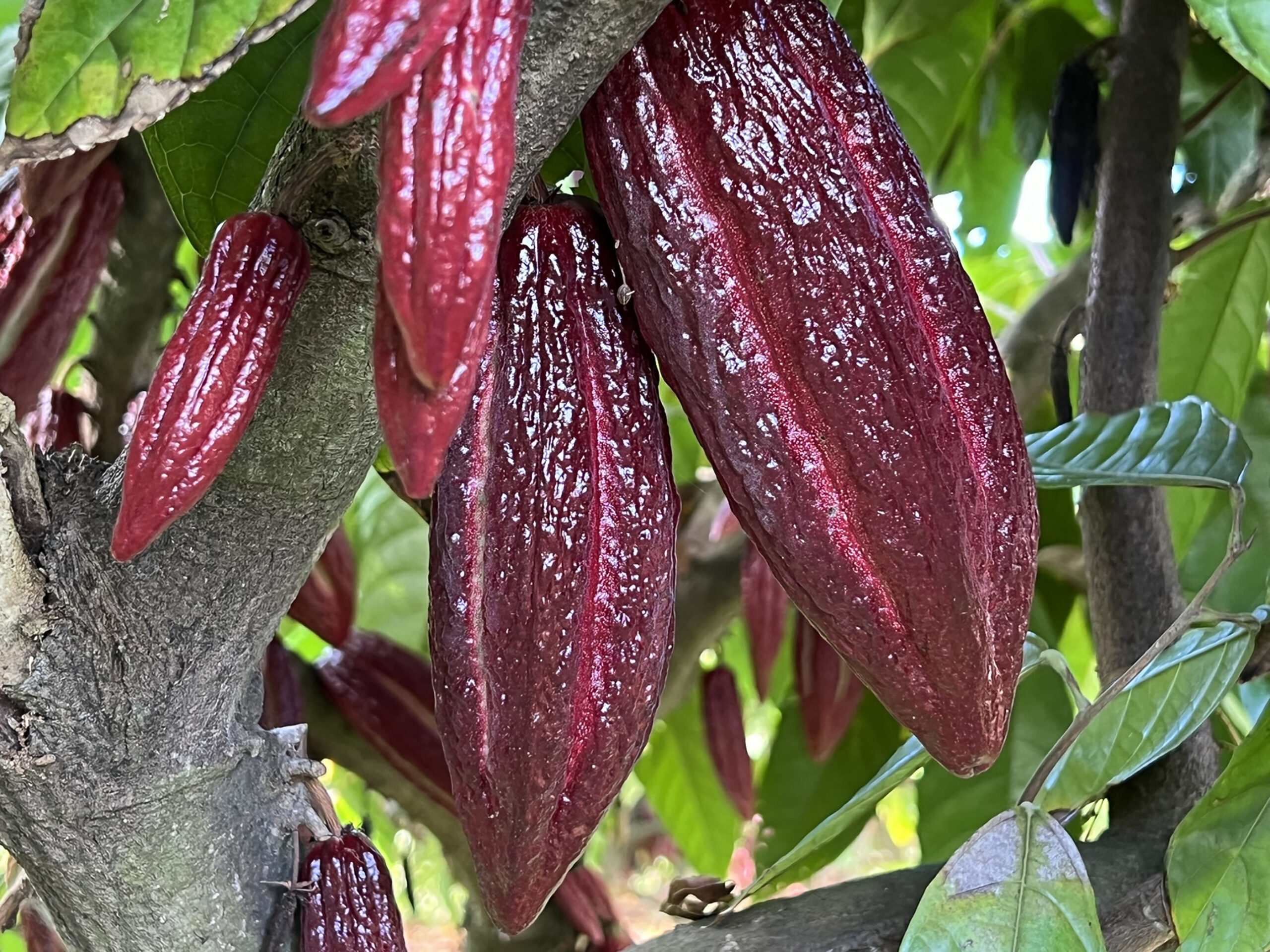
Chocolate and the Hawaiian Dream Comes True
By Liz Macklin
Sign up for our monthly newsletter!
After a January storm pummeled lowlands with six inches of rain, sunlight washed across white sand beaches, but our van drove past the sparkling lagoons and high surf of Oahu’s North Shore. I rode with five fellow travelers, and we had one destination in mind: the Nine Fine Mynahs Chocolate House. Years earlier at the Smithsonian’s National Museum of the American Indian, I’d examined cacao pods and heard about how people make mouthwatering chocolate, but this trip was a first for me to Hawaii to see a thriving grove of cacao trees and hear about the process directly from the grower and chocolatier. We pulled up to a building with a welcoming sign and flowering plants near the entry. The place had an air of friendly comfort, and as I learned later, the residence and the farm are for sale.
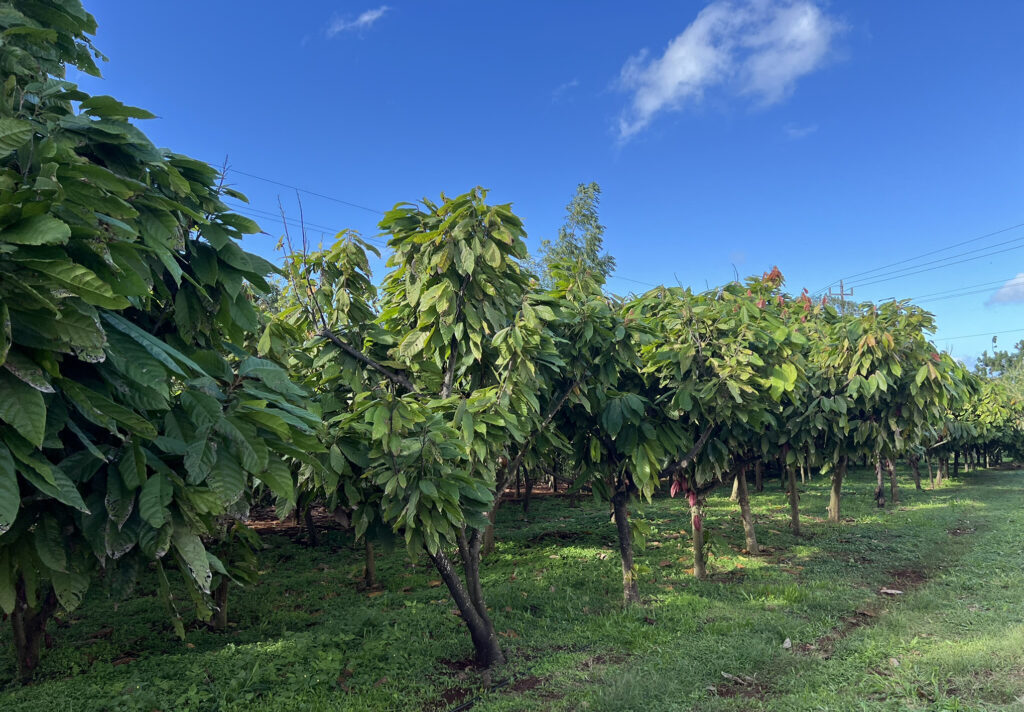
Bruce Clements, owner of Nine Fine Mynahs Cacao Farm, greeted us at the door of their newly built store – a lab where he and his wife Jeanne Bennett transform beans into chocolate and greet customers drawn to the farm by something so delicious. Their story began with the purchase of five acres on a plain in Oahu in 2013. He had retired from a career as a Hawaiian airline pilot. Jeanne had worked piloting tugboats and submarines, showing tourists the wonders of the world of whales, turtles and other incredible, sometimes luminescent sea creatures. They wanted a change, and the idea of living on a bountiful property and growing a popular crop appealed to them. The land had stood bare for over 30 years with no water, no electricity, no paved road, no trees. Together, they researched the benefits of chocolate and learned that a major portion of the world’s cacao was threatened by biological and sociological hazards. With a commitment to growing a sustainable orchard, they collected soil samples and fertilized as needed. They planted 600 cacao trees, including 10 of a rare Jaguar variety.
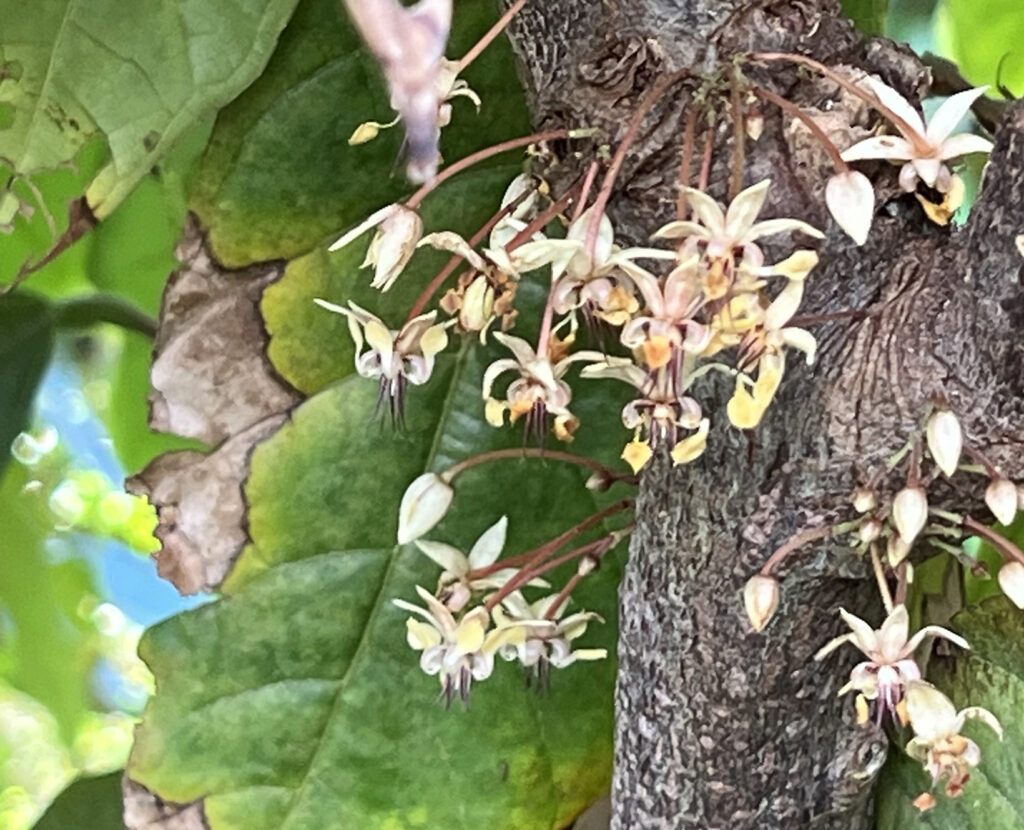
To this day the couple takes care of most maintenance themselves with a keen commitment to responsible farming techniques. They prune branches to let air circulate in the canopy, and they trim the trees to 15 feet high to simplify harvesting. Irrigation is essential in dry periods when about 4000 gallons of water a day can go into the fields. During the rainy season, weeds and leaves flourish, so they step in again to clear open spaces and let sunshine and cleansing air flow among the trees.
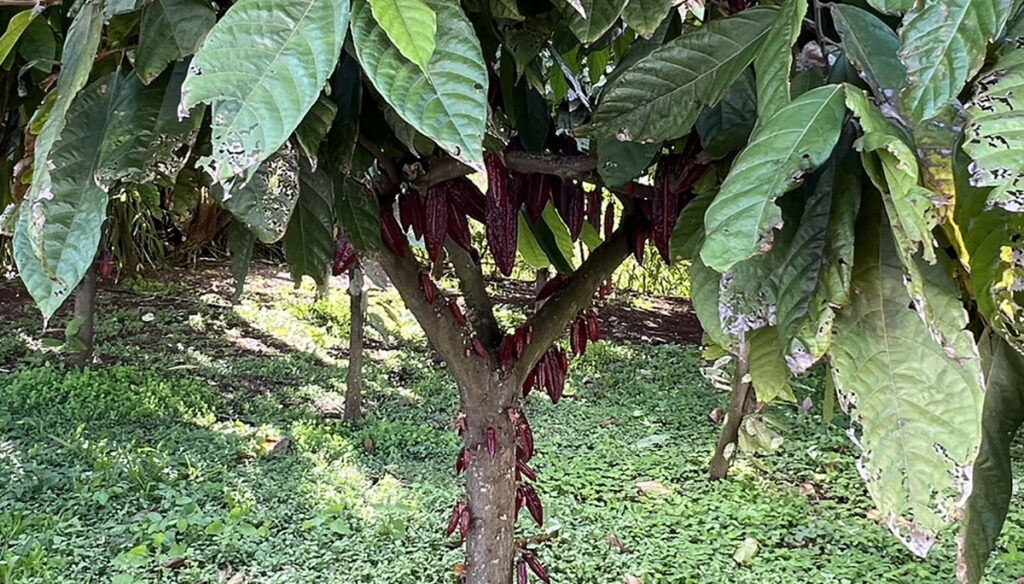
Their goal is to preserve a healthy ecosystem and a protected area for wildlife, including a space for rescued mynah birds. Mynahs came to the Hawaiian Islands in the 1860s, brought from Asia to control insects in the sugar cane fields. They quickly adapted to the lush island habitat. When the sugar industry faded, mynahs had grown fond of fruits like papayas and mangos and became regarded as a problem, even as invasive.
Jeanne first came upon mynahs, as she sat alone in a coffee shop, relaxing and reading a book. A group of four tourists confronted her and one held out a tiny bird. They begged her to take it. She looked up and thought Gee, I’d rather sit here and read. The little bird was oily and dirty. With such greasy, matted feathers, it looked like the saddest thing she’d ever seen. The tourists cried and said, “It’s going to die if you don’t take it!” They convinced her to bring it home.
She called a local rescue group, took the bird to the vet, and gave it a gentle cleanup and daily food and water. She named it Jasper. There were challenges, but Jeanne said, “Once it was all done, that was the happiest being I’ve ever met. The moment the little bird woke up, she was practically shaking with excitement about the day. Just ‘Cheep, cheep, cheep!’ and everything was wonderful. She was with us for about five years.”
At the farm several of the rescued mynahs live indoors. A few when ready are allowed outdoors, and along with chickens and egrets, act as unofficial guardians of the trees, eating insects, mice and other small rodents that could harm the cacao.
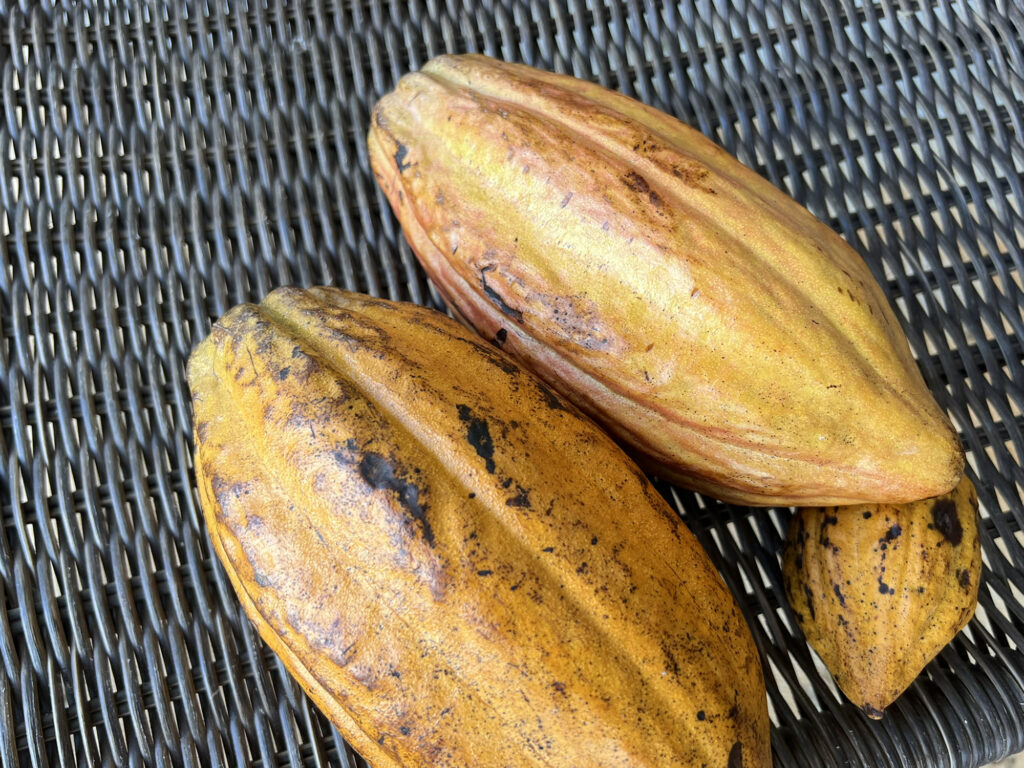
Harvesting of cacao pods begins in December and continues every two weeks until late spring. Beans dry exposed to fresh air in a nearby screened structure. The trees have a dormant period in the summer, yet there’s no such thing as down time. In the chocolatier’s kitchen, Jeanne and Bruce make bars and other chocolate products.
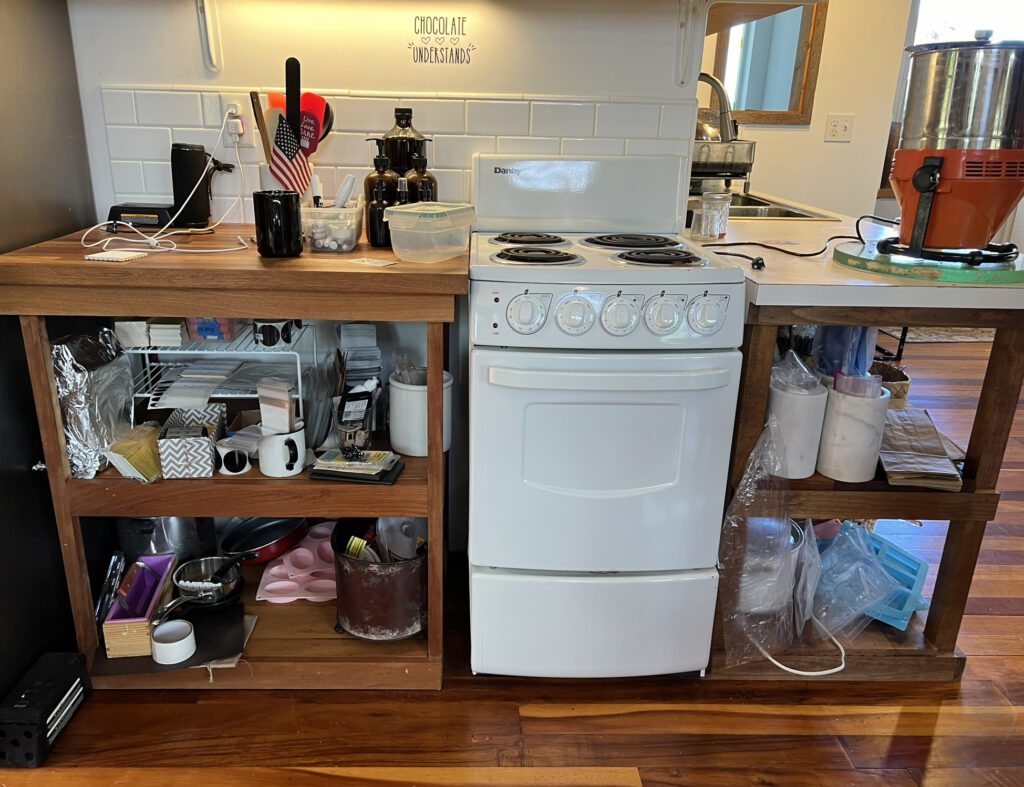
While showing us his workspace Bruce pointed out essential equipment, including a roasting oven, a cracking machine and a vacuum cleaner that sucks off husks and deposits cacao nibs below. Nibs and organic sugar go into a grinder for 24 hours. After that the chocolate tastes fine but is crumbly, so Bruce moves the mixture to the tempering machine. For about two hours the machine heats, then cools and again heats, taking the mixture to 91 degrees. The resulting chocolate becomes “in temper” – smooth and homogenous – and can be poured into molds to make bars and sweets.
In 2017 Bruce and Jeanne traveled to Paris to the Salon du Chocolat, part of the Biodiversity International Cocoa of Excellence competition. The first batch of cacao ever produced at Nine Fine Mynahs Farm won one of 18 highest awards – the prize for the Asia, Pacific and Australia division. Jeanne described the final day of celebration.
“There was a big bleacher full of paparazzi from all over the world taking photos… Parisian models in chocolate dresses walked down the runway to the music of a world-famous DJ. There were people from all over the world who had entered and either become semifinalists or won, and they were in their native dresses, so there was an extremely international feel. Ed Seguine, who had done all the work to ready the cacao for judging, roasting and making chocolate liqueur for them to taste — he was crying. I stole a glance at him as we were called up on stage. They played my favorite song ‘When I ruled the world…’ by Coldplay, while we went on stage to receive our award… We were just country bumpkins, wearing our Aloha shirts and leis, carrying an American flag and a Hawaii state flag. We were going to do our part to represent our state and our country. I was pretty overcome. There was champagne on silver trays and trays of chocolate delicacies. It was an amazing night.”
While in Paris they asked, “What is it about the chocolate? You say it is so fruity and has such a smooth taste. Why is that?”
Master chocolatier Ed Sequine heard their request many times, grew tired of it, and finally said, “We really don’t know. What is it that you do on your farm?”
Bruce replied, “Well, we rescue mynah birds and we release [some] back into the environment.”
And Ed said, “Maybe it’s the mynah birds that live there.”
Jeanne looked at him, expecting him to laugh, and he was perfectly serious.
Their search for explanations led to more ideas. One theory held that over time, even over millions of years, air currents above Hawaii brought sand and a variety of rare trace minerals to the islands. These rare earth elements occur in low concentrations in the earth’s crust, and some have important powers related to magnetism or emission of light. Those carried by wind can fall to earth in rain and remain present in the soil. When absorbed by plants certain elements might also act as catalysts, stimulating genes in subtle ways to create substances that possibly affect aroma and flavor.
Jeanne said that many factors probably affect the trees and the cacao. She described the diversity of plants surrounding the orchard, reflecting on how a special microclimate results. She and Bruce searched local stores and plant sales for everything available that was native and would survive the wind, the compact soil, and the lack of humus on the land. Many neighbors also donated rare or endangered plants. She told of a cacao farm, where trees survived a disease outbreak, while surrounding farms suffered tremendous losses. Investigators credited the biodiverse ecosystem with possible protection against pathogens. She described what she’s learned about how plants share nutrients and how mycorrhizal networks often connect trees. She referred to a study of early morning bird chirps that suggested another potential influence. Their vibrations might help to open the stoma on leaves, starting respiration. In Jeanne’s words, “I can’t sense everything that’s happening, but there is a lot going on.”
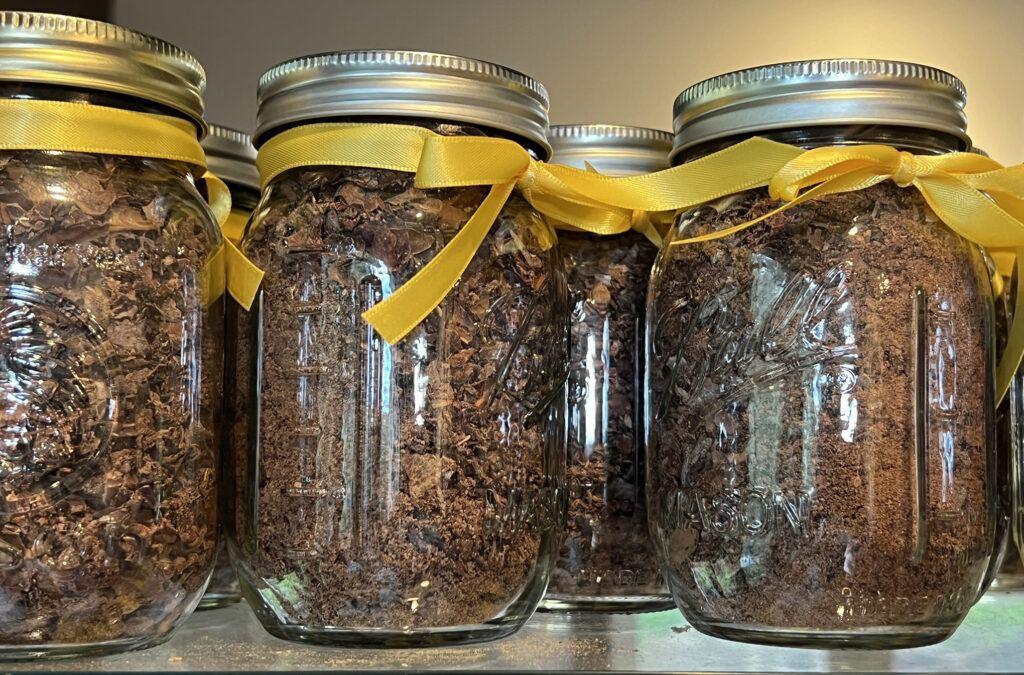
After the competition, imagination energized the couple’s work. They continued to experiment with adding chocolate to other confections and even baked goods, as well as producing chocolate tea, soap, bath scrubs and perfume. They completed design and construction of the Nine Fine Mynahs Chocolate House, as a place to sell their chocolate and as a lab to showcase its preparation. Through it all, they practiced principles of permaculture, making minimal use of pesticides, offering places for native animals to bear and rear their young, and providing water and food like fruit, flowers and nuts for animals.
Of course, time brings changes. The property, its rare plants, the wildlife pond, the trees and the parklike atmosphere are available for sale. Jeanne spoke of her thoughts about leaving and her hope that the person who buys the farm will enjoy it.
“We don’t know what the happiness of a human being adds to the environment… maybe being kind to the wildlife has effects. There are butterflies, birds and lizards… Just on this lot I’ve seen turkey… quail, pheasant, purple birds, wild chickens, different kinds of ducks, even one of the most endangered birds, the Hawaiian moorhen, down on our pond…It’s a shame to leave it, but maybe I’ll be glad I left that on the planet.”
The new owners will have a unique opportunity.
For now, the statement on the chocolate labels says it all: “Your purchase supports our melding of wild bird rescue and rehabilitation, habitat restoration and public awareness with healthy permaculture and farming practices… Handcrafted Bean-to-Bar.” Remarkable and delicious!
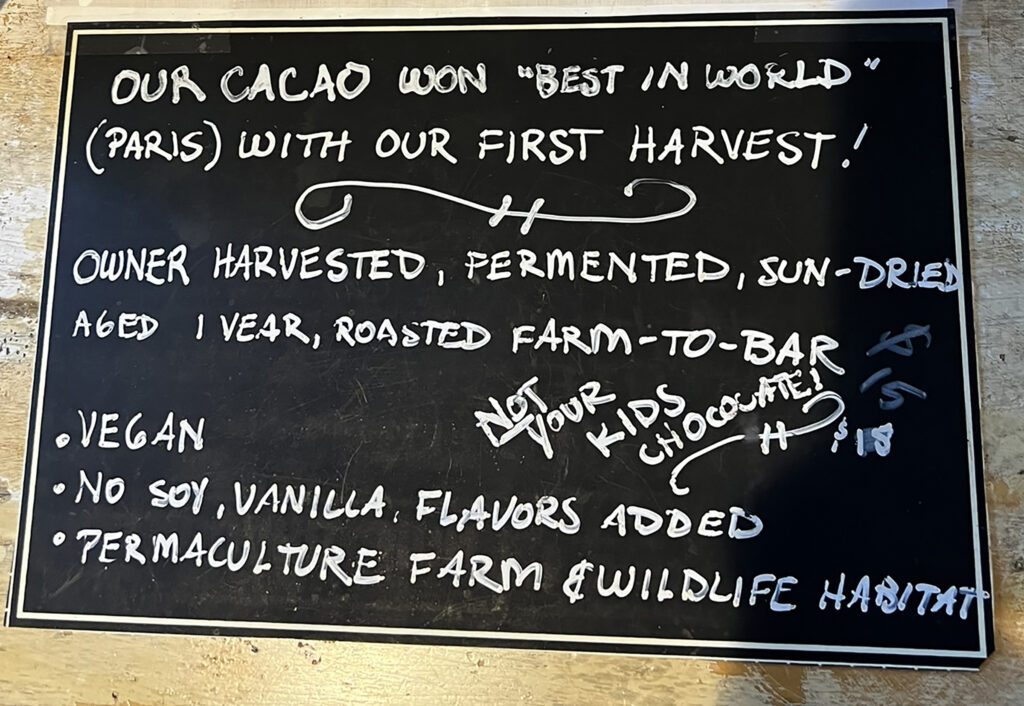
Liz Macklin is an artist, writer and former architect, who enjoys exploring country roads, especially those leading to spots like the Hawaiian cacao farm. Thank you to Bruce Clements, Jeanne Bennett and fellow travelers Becky, Carolyn, Kay Bea, Marybeth and Terry for their help in creating this article.
© Photos 2024 by Liz Macklin
Detailed descriptions of the Nine Fine Mynahs Farm, as well as ways to purchase chocolate and other merchandise can be found at http://ninefinemynahscacao.com
“The Myna and the Cacao Tree,” a video about the lives of people, mynahs and other visitors to the farm was produced by BetterWorld4Kids and is available on YouTube.
The Honolulu Star Advertiser published an article about Nine Fine Mynah’s award titled “Cacao Champs: Hawaii growers are recognized at the prestigious biennial Salon du Chocolat in Paris,” written by Pat Gee in its Wednesday, December 27, 2017 edition.
To learn more about items related to chocolate and the 2017 Chocolate Festival at the National Museum of the American Indian, see the Smithsonian Institution’s site: https://www.si.edu/spotlight/chocolate
Plantings
Issue 30 – December 2023
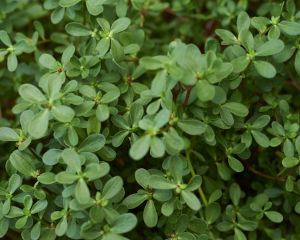
Viriditas: Musings on Magical Plants: Portulaca oleracea
By Margaux Crump
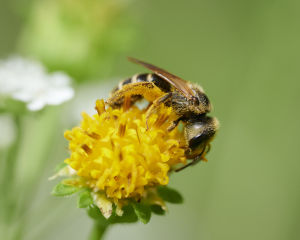
Proboscis, Pollen, and the Rapture of Interspecies Intimacy
By Jake Eshelman
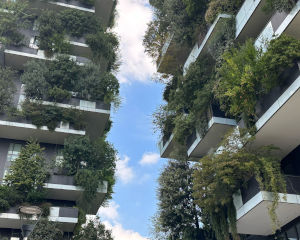
The Greening of Milan: Porta Nuova and Vertical Forest
By Gayil Nalls

Overshooting Earth’s Boundaries: An Interview with Bill Rees
By Rachel Donald
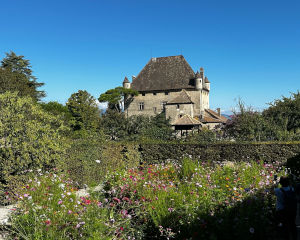
The Garden of the Five Senses
By Gayil Nalls
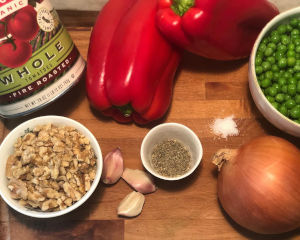
Eat More Plants Recipes:
Le Botaniste’s Fennel, Tomato, and Red Pepper Pasta Sauce

As Ireland transitions from the rich, smoky scent of peat-burning to a more sustainable future, its olfactory heritage is evolving. What will become the next iconic aromatic symbol of Ireland?
Click to watch the documentary trailer.


